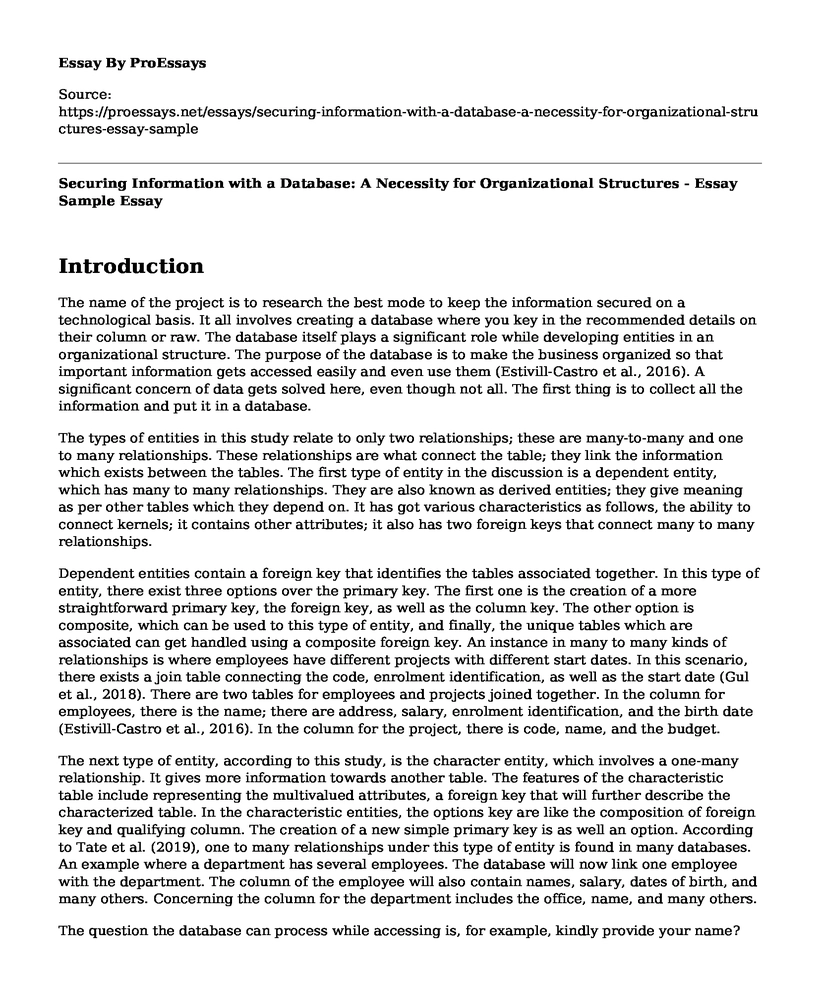Introduction
The name of the project is to research the best mode to keep the information secured on a technological basis. It all involves creating a database where you key in the recommended details on their column or raw. The database itself plays a significant role while developing entities in an organizational structure. The purpose of the database is to make the business organized so that important information gets accessed easily and even use them (Estivill-Castro et al., 2016). A significant concern of data gets solved here, even though not all. The first thing is to collect all the information and put it in a database.
The types of entities in this study relate to only two relationships; these are many-to-many and one to many relationships. These relationships are what connect the table; they link the information which exists between the tables. The first type of entity in the discussion is a dependent entity, which has many to many relationships. They are also known as derived entities; they give meaning as per other tables which they depend on. It has got various characteristics as follows, the ability to connect kernels; it contains other attributes; it also has two foreign keys that connect many to many relationships.
Dependent entities contain a foreign key that identifies the tables associated together. In this type of entity, there exist three options over the primary key. The first one is the creation of a more straightforward primary key, the foreign key, as well as the column key. The other option is composite, which can be used to this type of entity, and finally, the unique tables which are associated can get handled using a composite foreign key. An instance in many to many kinds of relationships is where employees have different projects with different start dates. In this scenario, there exists a join table connecting the code, enrolment identification, as well as the start date (Gul et al., 2018). There are two tables for employees and projects joined together. In the column for employees, there is the name; there are address, salary, enrolment identification, and the birth date (Estivill-Castro et al., 2016). In the column for the project, there is code, name, and the budget.
The next type of entity, according to this study, is the character entity, which involves a one-many relationship. It gives more information towards another table. The features of the characteristic table include representing the multivalued attributes, a foreign key that will further describe the characterized table. In the characteristic entities, the options key are like the composition of foreign key and qualifying column. The creation of a new simple primary key is as well an option. According to Tate et al. (2019), one to many relationships under this type of entity is found in many databases. An example where a department has several employees. The database will now link one employee with the department. The column of the employee will also contain names, salary, dates of birth, and many others. Concerning the column for the department includes the office, name, and many others.
The question the database can process while accessing is, for example, kindly provide your name? Your email address? And even the position in the company. The same can be helpful while accessing the database to keep off foreigners. The database will be used mostly by employees, while the administrator will administer. Employees access the same because they are in duty and even submit the daily report in which administrators enhance supervision. Similarly, the system can get organized in the form of a link that the two parties can access it without going through the database.
References
Estivill-Castro, V., Limongelli, C., Lombardi, M., & Marani, A. (2016, July). Dajee: A dataset of joint educational entities for information retrieval in technology enhanced learning. In Proceedings of the 39th International ACM SIGIR conference on Research and Development in Information Retrieval (pp. 681-684). https://dl.acm.org/doi/10.1145/2911451.2914670
Gul, N., Qureshi, I. M., Akbar, S., Kamran, M., & Rasool, I. (2018). One-to-many relationship based kullback leibler divergence against malicious users in cooperative spectrum sensing. Wireless Communications and Mo https://www.hindawi.com/journals/wcmc/2018/3153915
Tate, T. D., Lartey, F. M., & Randall, P. M. (2019). Relationship between Computer-Mediated Communication and Employee Engagement among Telecommuting Knowledge Workers. Journal of Human Resource and Sustainability Studies, 7(02), 328. https://www.scirp.org/journal/PaperInformation.aspx?PaperID=93340
Cite this page
Securing Information with a Database: A Necessity for Organizational Structures - Essay Sample. (2023, Jul 18). Retrieved from https://proessays.net/essays/securing-information-with-a-database-a-necessity-for-organizational-structures-essay-sample
If you are the original author of this essay and no longer wish to have it published on the ProEssays website, please click below to request its removal:
- Management Essay Example: Tools for Strategic Implementation
- Errors in the Problem-Solving Process Essay Example
- Challenges Posed by Culture to International Business Paper Example
- FedEx Corporation Case Study Paper Example
- Paper Example on Creating an Effective Security Plan Using an Enterprise Architecture
- Essay Sample on Operational Strategy: Key for Business Success
- Project Evaluators: Vital Role in Project Planning & Management - Essay Sample







